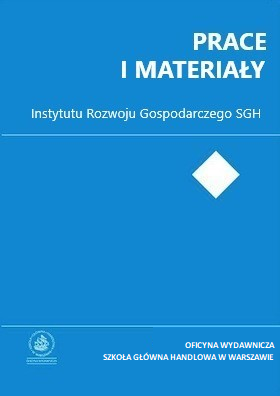Income Convergence in the EU Countries: Monthly Approach
Main Article Content
Abstract
The aim of the article is to verify the f convergence hypothesis for the whole EU28 group with the use of monthly data. On the basis of turning points in the economic growth paths of EU countries, identified using hidden Markov models, the structural breakdowns in 2008 and 2013 were introduced into the regression model. The added value of the study is monthly estimates of the convergence rate based on extrapolated time series using monthly values of the economic sentiment indicator. The f convergence hypothesis was positively verified on the basis of monthly data. It turned out, however, that the convergence was taking place at different rates between the turning points. In addition, large deviations in estimates for extrapolated monthly data were observed in relation to results based on official annual time series. Convergence analysis based on the monthly basis allows to get a more precise picture of the economic growth paths in EU countries.(original abstract)
Article Details
References
Adamowicz, E., Dudek, S., Pachucki, D., Walczyk K. (2012). Wahania cykliczne w Polsce i strefie euro. Prace i Materiały Instytutu Rozwoju Gospodarczego, 89.
Adamowicz, E., Dudek, S., Walczyk, K. (2004). The use of survey data in macroeconomic analysis. Prace i Materiały Instytutu Rozwoju Gospodarczego, 74: 357-375.
Bank Światowy (2017). World Development Indicators Database, http://databank.worldbank.org/ (data dostępu 20.09.2017).
Barro, R., Sala-i-Martin, X. (2003). Economic Growth, Cambridge-London: The MIT Press.
Batóg, J. (2013). Analiza krańcowej pionowej konwergencji dochodowej typu β w krajach Unii Europejskiej w latach 1993-2010. Studia i Prace Wydziału Nauk Ekonomicznych i Zarządzania, 31: 39-47.
Bernardelli, M., Próchniak, M., Witkowski, B. (2017). Cycle and income-level convergence in the EU countries: An identification of turning points based on the hidden Markov models. Roczniki Kolegium Analiz Ekonomicznych, 47: 27-42.
Borsi, M. T., Metiu, N. (2013). The evolution of economic convergence in the European Union. Deutsche Bundesbank Discussion Paper, 28/2013.
Eurostat (2018). Database, http://ec.europa.eu/eurostat (data dostępu 03.01.2018).
Forgó, B., Jevčak, A. (2015). Economic convergence of Central and Eastern European EU member states over the last decade (2004-2014). European Economy Discussion Paper, 001.
Grzelak, A., Kujaczyńska, M. (2013). Real convergence of the European Union member states - Evaluation attempt. Management, 17: 394-405.
Jóźwik, B. (2017). Realna konwergencja gospodarcza państw członkowskich Unii Europejskiej z Europy Środkowej i Wschodniej. Transformacja, integracja i polityka spójności. Warszawa: Wydawnictwo Naukowe PWN.
Malaga, K. (2004). Konwergencja gospodarcza w krajach OECD w świetle zagregowanych modeli wzrostu, Poznań: Wydawnictwo Akademii Ekonomicznej.
Mankiw, N. G., Romer, D., Weil, D. N. (1992). A contribution to the empirics of economic growth. Quarterly Journal of Economics, 107: 407-437.
Matkowski, Z. (1999). Barometry koniunktury dla gospodarki polskiej. Prace i Materiały Instytutu Rozwoju Gospodarczego, 64.
Matkowski, Z., Próchniak, M. (2008). Cyclical fluctuations in Central and Eastern Europe and their conformity with the Euro Area. referat przedstawiony podczas 29. konferencji CIRET, Santiago (Chile), 8-11 października.
Matkowski, Z., Próchniak, M., Rapacki, R. (2016a). Income convergence in Poland vis-à-vis the EU: Major trends and prospects. w: Weresa M. A. (red.). Poland. Competitiveness Report 2016. The Role of Economic Policy and Institutions. Warsaw: WSE, 37-55.
Matkowski, Z., Próchniak, M., Rapacki, R. (2016b). Real income convergence between Central Eastern and Western Europe: Past, present, and prospects. Ekonomista, 6: 853-892.
Międzynarodowy Fundusz Walutowy (2017). World Economic Outlook Database. http://www.imf.org/external/pubs/ft/weo/2017/01/weodata/ index.aspx (data dostępu 20.09.2017).
Monfort, M., Cuestas, J. C., Ordóñez, J. (2013). Real convergence in Europe: A cluster analysis. Economic Modelling, 33: 689-694.
Mucha, M. (2012). Mechanizm dywergencji gospodarczej w strefie euro. Ekonomista, 4: 487-498.
Nonneman, W., Vanhoudt, P. (1996). A further augmentation of the Solow model and the empirics of economic growth for OECD Countries. Quarterly Journal of Economics, 111; 943-953.
Próchniak, M. (2018). Zbieżność poziomów dochodu między Europą Środkowo-Wschodnią a Europą Zachodnią w: Weresa, M. A., Kowalski, A. M. (red.). Polska. Raport o konkurencyjności 2018. Rola miast w kształtowaniu przewag konkurencyjnych Polski. Warszawa: SGH, 31-43.
Próchniak, M., Witkowski, B. (2013). Time stability of the beta convergence among EU countries: Bayesian model averaging perspective. Economic Modelling, 30: 322-333.
Próchniak, M., Witkowski, B. (2016). Konwergencja dochodowa typu beta w ujęciu teoretycznym i empirycznym. Warszawa: SGH.
Rapacki, R., Gardawski, J., Czerniak, A., Horbaczewska, B., Karbowski, A., Maszczyk, P., Próchniak, M., Towalski, R. (2017). Wyłaniające się modele kapitalizmu w nowych krajach członkowskich UE w Europie Środkowej i Wschodniej, referat przedstawiony na konferencji pt. Modele społeczno-polityczne państwa. Państwo jako obiekt zmiany w warunkach przesileń cywilizacyjnych, organizowanej przez Polską Akademię Nauk oraz Polskie Towarzystwo Ekonomiczne, Jabłonna, 18-19 października.
Rapacki, R., Próchniak, M. (2007). Konwergencja beta i sigma w krajach postsocjalistycznych w latach 1990-2005. Bank i Kredyt, 8-9: 42-60.
Rapacki, R., Próchniak, M. (2014). Wpływ członkostwa w Unii Europejskiej na wzrost gospodarczy i realną konwergencję krajów Europy Środkowo-Wschodniej. Ekonomia, 39: 87-122.
Rogut, A., Roszkowska, S. (2006). Konwergencja warunkowa w krajach transformacji. Gospodarka Narodowa, 9: 35-55.
Solow, R. M. (1956). A contribution to the theory of economic growth. Quarterly Journal of Economics, 70: 65-94.
Staňisić, N. (2012). The effects of the economic crisis on income convergence in the European Union. Acta Oeconomica, 62: 161-182.
